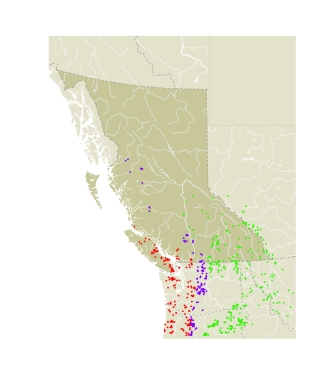The genus Speyeria is named for the German lepidopterist Adolph Speyer (1812-92). The name "greater fritillaries" refers to the large size of the species in this genus, in contrast to the lesser fritillaries in the genera Boloria and Clossiana.
At least some populations of all species of Speyeria in BC have individuals with silver spots on the ventral hindwing. By contrast, only one species of Clossiana has these silver spots. The genus is entirely Nearctic, with 14 recognized species, 9 of which are found in BC. Two other species, S. coronis (Behr, 1864) and S. egleis (Behr, 1862) occur immediately south of the BC border in Washington or Montana, and might eventually be recorded in the province. Dos Passos and Grey (1947) produced the definitive treatment of the genus. In this genus, and all genera in the subfamily except Boloria and Clossiana, the aedeagus is open at the proximal end. Dos Passos and Grey (1947) reduced the number of recognized species from more than 100 species to 13 species, and reduced the other species names to either subspecies or synonyms. The dos Passos and Grey paper, Gunder (1929b), Davenport (1941), and Nabokov (1949) set the standard for our modern species concepts for North American butterflies. P.A. Hammond (pers. comm.) has provided the information on the biology and appearance of the larvae.
|
|
